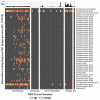Pseudomonas PB1-Like Phages: Whole Genomes from Metagenomes Offer Insight into an Abundant Group of Bacteriophages
- PMID: 29914169
- PMCID: PMC6024596
- DOI: 10.3390/v10060331
Pseudomonas PB1-Like Phages: Whole Genomes from Metagenomes Offer Insight into an Abundant Group of Bacteriophages
Abstract
Despite the abundance, ubiquity and impact of environmental viruses, their inherent genomic plasticity and extreme diversity pose significant challenges for the examination of bacteriophages on Earth. Viral metagenomic studies have offered insight into broader aspects of phage ecology and repeatedly uncover genes to which we are currently unable to assign function. A combined effort of phage isolation and metagenomic survey of Chicago’s nearshore waters of Lake Michigan revealed the presence of Pbunaviruses, relatives of the Pseudomonas phage PB1. This prompted our expansive investigation of PB1-like phages. Genomic signatures of PB1-like phages and Pbunaviruses were identified, permitting the unambiguous distinction between the presence/absence of these phages in soils, freshwater and wastewater samples, as well as publicly available viral metagenomic datasets. This bioinformatic analysis led to the de novo assembly of nine novel PB1-like phage genomes from a metagenomic survey of samples collected from Lake Michigan. While this study finds that Pbunaviruses are abundant in various environments of Northern Illinois, genomic variation also exists to a considerable extent within individual communities.
Keywords: Pbunaviruses; Pseudomonas phage PB1; bacteriophage; uncultivated phage genomes.
Conflict of interest statement
The authors declare no conflict of interest.
Figures



Similar articles
-
Three novel Pseudomonas phages isolated from composting provide insights into the evolution and diversity of tailed phages.BMC Genomics. 2017 May 4;18(1):346. doi: 10.1186/s12864-017-3729-z. BMC Genomics. 2017. PMID: 28472930 Free PMC article.
-
Comparative genomic analysis of Pseudomonas aeruginosa phage PaMx25 reveals a novel siphovirus group related to phages infecting hosts of different taxonomic classes.Arch Virol. 2017 Aug;162(8):2345-2355. doi: 10.1007/s00705-017-3366-5. Epub 2017 May 2. Arch Virol. 2017. PMID: 28462462
-
Pseudomonas Phage MD8: Genetic Mosaicism and Challenges of Taxonomic Classification of Lambdoid Bacteriophages.Int J Mol Sci. 2021 Sep 26;22(19):10350. doi: 10.3390/ijms221910350. Int J Mol Sci. 2021. PMID: 34638693 Free PMC article.
-
Computational approaches to predict bacteriophage-host relationships.FEMS Microbiol Rev. 2016 Mar;40(2):258-72. doi: 10.1093/femsre/fuv048. Epub 2015 Dec 9. FEMS Microbiol Rev. 2016. PMID: 26657537 Free PMC article. Review.
-
Computational Tools for the Analysis of Uncultivated Phage Genomes.Microbiol Mol Biol Rev. 2022 Jun 15;86(2):e0000421. doi: 10.1128/mmbr.00004-21. Epub 2022 Mar 21. Microbiol Mol Biol Rev. 2022. PMID: 35311574 Free PMC article. Review.
Cited by
-
Monitoring phage-induced lysis of gram-negatives in real time using a fluorescent DNA dye.Sci Rep. 2023 Jan 16;13(1):856. doi: 10.1038/s41598-023-27734-w. Sci Rep. 2023. PMID: 36646746 Free PMC article.
-
Pseudomonas Diversity Within Urban Freshwaters.Front Microbiol. 2019 Feb 15;10:195. doi: 10.3389/fmicb.2019.00195. eCollection 2019. Front Microbiol. 2019. PMID: 30828321 Free PMC article.
-
Complete Genome Sequence of Serratia marcescens Myophage MyoSmar.Microbiol Resour Announc. 2019 Sep 19;8(38):e01046-19. doi: 10.1128/MRA.01046-19. Microbiol Resour Announc. 2019. PMID: 31537681 Free PMC article.
-
The C-terminus of the tail fiber protein of PB1-like phages is responsible for the host recognition.Virus Genes. 2025 Jul 10. doi: 10.1007/s11262-025-02175-x. Online ahead of print. Virus Genes. 2025. PMID: 40637811
-
Isolation and Characterization of Lytic Bacteriophages Capable of Infecting Diverse Multidrug-Resistant Strains of Pseudomonas aeruginosa: PaCCP1 and PaCCP2.Pharmaceuticals (Basel). 2024 Nov 30;17(12):1616. doi: 10.3390/ph17121616. Pharmaceuticals (Basel). 2024. PMID: 39770458 Free PMC article.
References
Publication types
MeSH terms
LinkOut - more resources
Full Text Sources
Other Literature Sources
Miscellaneous

